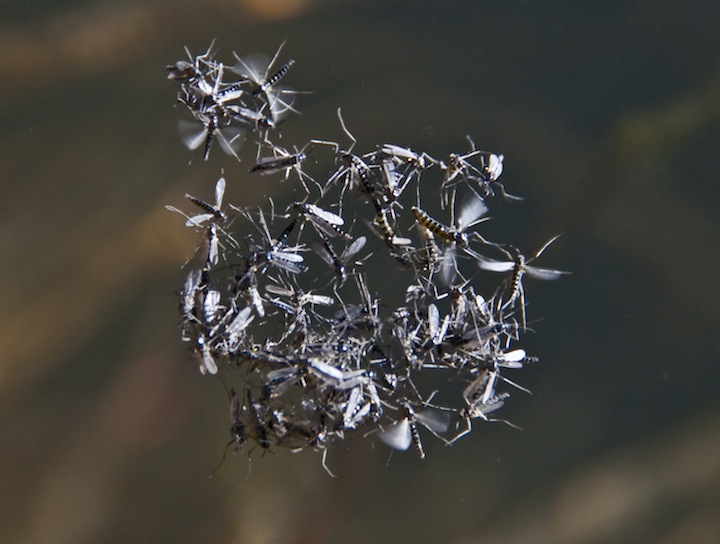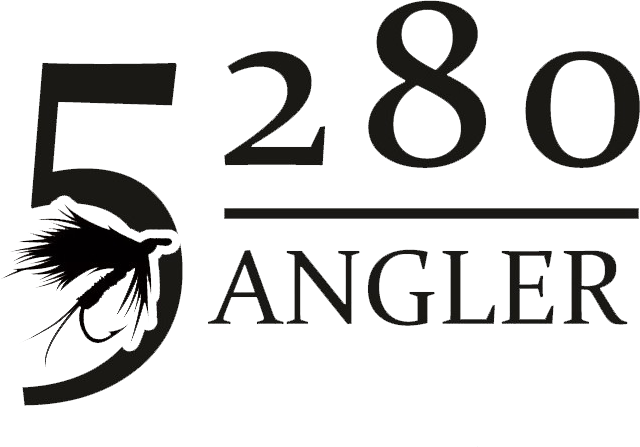
If you’re of one of those fly fishers who packs away the gear at the first sign of snow, you’re missing out on a very special type of fishing. Unknown to some fly anglers is the fact that, during the winter months, there is a hatch of tiny insects that can make the long winter loads of fun for fly anglers.
Midges are aquatic insects that some fly anglers believe are impractical to imitate due to their small size. The truth of the matter is, midges in the adult and larval stages make up only a very small portion of the trout’s respective diet; however, with the scarcity of food during the cold winter months, even tiny flies become a sought after food source by hungry trout.
When looking streamside for hatches of midges, don’t expect to see large, dense flies hovering above the water surface. Adult midges are tiny insects that typically hatch in small numbers and are barely noticeable to the untrained eye. For fly anglers, learning to key on these mid-winter insects can be the difference between landing your limit and catching a cold.
Although the majority of fly fishermen dream of casting dries to large surface feeding trout, this isn’t always the best way to catch fish, especially mid-winter. During the winter months, you’ll find the regular aquatic nymphs and worms, but the dominate food source present should be midge larvae and Pupa.
Midge larvae live along the bottom of the stream hiding under any rock or cover they can find to protect themselves from feeding predators and current. If these tiny insects happen to get disturbed from their resting place and swept into the current, they will drift helplessly downstream until either coming back into contact with the bottom or falling prey to a hungry trout.
Midge larvae and Pupa are very small, dark, thin-bodied critters, so picking a good fly to use should incorporate these special characteristics. Patterns tied on 18-24 size hooks using black flosses and tiny wire ribbing seem to be the standard, with a small tuft of white CDC or ice dubbing to create a visible thorax.
Because of the Doppler Shift in the color spectrum as light penetrates the water, certain colors are more effective in the low light conditions commonly found in the winter months. It is for that reason why the dark neutrals such as black, browns, olives, and certain grays tend to work a little better in the winter months than the colors found on the higher end of the color spectrum such as reds, oranges, and yellows.
Blues and Purples also tend to be good color choices in addition to the dark neutrals. I like to add gold, clear, and dark beads (peacock or gunmetal) to some patterns not only to enhance the profile but also to assist with their getting to the bottom quicker.
To fish these larval patterns, the fly angler needs to have extreme patience during drifts. Winter midge fishing is not similar to any other nymph tactic because fish do not aggressively search out food this time of year. This forces the angler to almost contact the trout with the fly in order to get a strike. This is very much unlike warm water fishing, where trout will actively search out and forage on anything drifting downstream that looks appealing.
When fishing midge larval and Pupal patterns (Brassie, Black Beauty, Bazuli), use an upstream and across presentation, positioning your fly above turbulent water or a fishy looking run. As the fly begins to drift downstream, it’s very important for anglers to mend fly line so that no drag is placed on the fly, allowing it to sink uninhibited. One good point to remember is that when fishing midge subsurface presentations, fish won’t usually strike flies on the first drift. It takes numerous drifts and patience to fish these types of patterns successfully. It is not uncommon to run your midge pattern 5 to 8 times or more through the same run the same way, only to get the take from fish on the very last drift.
If you’re brave enough to wander out into the ice-cold river and find adult midges hatching or returning to the river, you can exploit this opportunity to catch large numbers of nice trout. During midge hatches, you shouldn’t expect to see adult flies hatching and sitting on the water’s surface. In most cases these insects spend very little time on the surface unless foul weather conditions hinder their progress.
In cold, wet conditions, emerging midge adults will have a hard time drying their wings, leaving them struggling helplessly on the surface. Ideally, dry-fly fishermen should look for a small cloud of midges flying low to the water’s surface. Because midges are so tiny, trout will rarely feed on individual flies since the return on investment for eating single flies is so small. These predators would rather come to the surface where they can take a dozen or so flies in one swoop.
Heavily hackled, dark-bodied, dry-fly patterns (Griffith’s Gnat) do a good job when trying to imitate these small clusters of midges. The many tiny hackle barbs look very similar to the many little wings of midges holding tightly together. Size 14 to 24 dry flies seem to be the standard amongst anglers, but catching a few of the real adult’s streamside will best alert you to the best fly size.
Actual midge clusters on the water surface will not just drift downstream motionless. These flies twitch and dance enticingly downstream, attracting hungry trout below. Dry-fly anglers should use standard dry-fly tactics to create drag free drifts, as well as incorporate small line strips into the retrieve to add an occasional hop or bounce to the fly.
What I’ve presented to you are the techniques and tactics I use to find fish for not only myself but also my clients when fishing the winter months. I encourage you to employ these tactics next time you make that journey to the stream/river during the cooler months. Don’t let the cooler weather and cooler water discourage you from pursuing winter trout. Knowing now what the trout are keying on should allow you to get out there and enjoy the fruits of winter fly fishing. I think you will find you have been missing out on some of the finest fishing of the year.
Until the next time – tight lines and good fishing!

